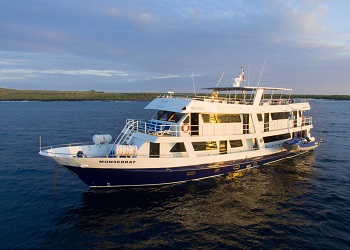Grand Majestic Itinerary A - 8 days
ITINERARY A - 8 DAYS
MONDAY
AM: San Cristobal Arrival and Transfer to the boat
PM: San Cristobal: El Junco Lagoon (HK)
TUESDAY
AM: Floreana: Post Office Bay (HK/SN/PR/KY)
PM: Floreana: Cormorant Point / Devil's Crown (HK/SN/PR/KY)
WEDNESDAY
AM: Espanola: Suarez Point (HK/SN)
PM: Espanola: Gardner Bay / Osborn Islet / Gardner Islet (HK/SN/PR/KY)
THURSDAY
AM: Santa Cruz: Twin Craters (HK)
PM: Santa Cruz: Interpretation Center Fausto Llerena (HK)
FRIDAY
AM: Genovesa: El Barranco (HK/SN/PR/KY)
PM: Genovesa: Darwin Bay (HK/SN/PR/KY)
SATURDAY
AM: Rabida (HK/SN/PR/KY)
PM: Chinese Hat (HK/SN/PR/KY)
SUNDAY
AM: San Cristobal: Witch Hill (HK/SN/PR/KY)
PM: San Cristobal: Lobos Island (HK/SN)
MONDAY
AM: San Cristobal: Interpretation Center (HK)
San Cristobal: Transfer to the Airport
HK: HIKE / SN: SNORKEL / PR: PANGA RIDE / KY: KAYAK /
PB: PADDLE BOARD
DAY 1: MONDAY
AM: SAN CRISTOBAL AIRPORT ARRIVAL AND TRANSFER TO THE BOAT.
PM: EL JUNCO LAGOON
The Junco Lagoon, located about 700 m above sea level, is one of the few permanent freshwater bodies in the Galapagos. Frigate birds are often seen here washing the salt from their feathers as well as white-cheeked pintails and common gallinules. Its name comes from a type of plant that is common in this area called “junco”.
DAY 2: TUESDAY
AM: FLOREANA: POST OFFICE BAY
In the 18th century whalers passing through the islands placed a wooden barrel on Floreana Island for use as an unofficial mail box. The tradition continues today as visitors leave addressed postcards in the barrel and sort through left mail to deliver at home.
PM: FLOREANA: CORMORANT POINT
This site hosts a large flamingo lagoon where other birds such as common stilts and white-cheeked pintails can also be seen. The beaches on this island are distinct: The “Green Beach” named so due to its green color, which comes from a high percentage of olivine crystals in the sand, and the “Four Sand Beach” composed of white coral.
DAY 3: WEDNESDAY
AM: ESPANOLA: SUAREZ POINT
This area is great for spotting blue-footed boobies, albatrosses and Nazca boobies. A beautiful site on the ocean front, the large waved albatrosses use the cliff as a launching pad. The famous attraction is the magnificent blowhole, spurting water high into the air. This site presents wonderful photograph opportunities.
PM: ESPANOLA: GARDNER BAY
Gardner Bay, on the eastern side of the island, is the breeding site of nearly all of the world´s 12,000 pairs of waved albatrosses. It has an ample white sandy beach with a myriad of sea lions, perfect for relaxing. Its rocky shores make this site a great place for diving and snorkeling.
DAY 4: THURSDAY
AM: SANTA CRUZ: TWIN CRATERS
Los Gemelos, or the Twin Craters, are located opposite each other on both sides of the road leading from Puerto Ayora to Baltra. The name is only figurative; not real craters, these formations were created by the collapse of surface material in underground fissures and chambers. The view is breathtaking.
PM: SANTA CRUZ: CHARLES DARWIN STATION / FAUSTO LLERENA BREEDING CENTER
The Charles Darwin Research Station is home to turtles ranging from 3-inches (new hatchlings) to 4-feet long. Subspecies of turtles interact with one another and many of the older turtles are accustomed to humans stretching out their heads for a photo opportunity. The babies are kept until they are about four years old and strong enough to survive on their own.
DAY 5: FRIDAY
AM: GENOVESA: EL BARRANCO
Also known as Prince Phillip's Steps, El Barranco’s steep, rocky paths leads up to a high cliff-face. A marvelous view can be appreciated from here. This site is also home to palo santo vegetation as well as red-footed boobies, short-eared lava owls, Galapagos swallows, and Galapagos doves.
PM: GENOVESA: DARWIN BAY
This white sand coral beach heads a half mile trail (0.75km) that winds through mangroves filled with land birds. Nazca boobies, red-footed boobies, and swallow-tailed gulls can be spotted here. Further down the path are tidal pools where sea lions swim playfully. At the end is a spectacular view off a cliff.
DAY 6: SATURDAY
AM: RABIDA ISLAND
Rabida Island (Jervis) is one of the most colorful and volcanically varied islands in the archipelago and a great snorkeling site. Its famous maroon sandy beach and stunning lookouts provide wonderful landscapes. The island is a birdwatcher’s delight. Some of the rarest species are in abundance, such as nine varieties of finches, large-billed flycatchers, Galapagos hawks and brown pelicans.
PM: CHINESE HAT ISLET
This small islet is located near the southeast coast of Santiago Island. Its name comes from the distinct shape of the islet's summit. This small islet is a great location to view many geological formations such as lava tubes and lava flows.
DAY 7: SUNDAY
AM: SAN CRISTOBAL: WITCH HILL
Located on the northern coast, this eroded hill and its surroundings present one of the most picturesque beaches in the Galapagos with its white powdery sand and the abundance of animals. Wildlife includes sea turtles, rays, and various types of booby birds. The clear water provides an excellent opportunity for enjoying swimming and snorkeling.
PM: SAN CRISTOBAL: LOBOS ISLAND
The name of this island means "Sea Lion Island." This appropriately named island is ripe with noisy, frolicking, jolly sea lions who will welcome you to their home with open, well, fins. This island also offers great snorkeling opportunities as well as the chance to see blue-footed and Nazca boobies.
DAY 8: MONDAY
AM: SAN CRISTOBAL: INTERPRETATION CENTER
The Interpretation Center was opened in 1998 as a phase of the project “Interpretation and Environment Education Project.” Visitors enjoy expositions on natural history, human history, and conservation. The conservation efforts represent the movement to protect the wildlife and natural environment through means of population and tourist control. The Interpretation Center has an outdoor stadium, audio-visual equipment, and meeting rooms.







